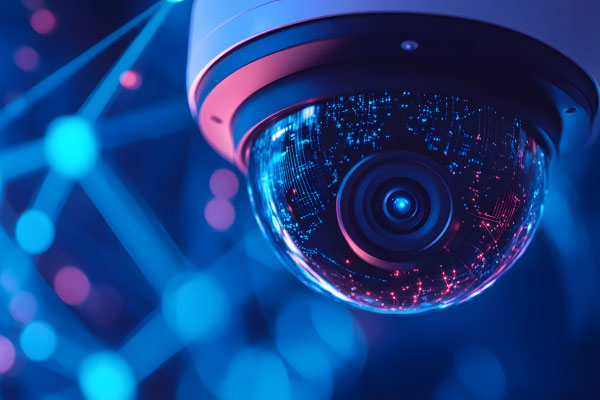Enhancing Security Officer Performance with AI and CCTV Integration

The Evolving Security Paradigm
By Mark Limon
Traditional security operations relied heavily on human vigilance and physical presence. Security officers would patrol designated areas, monitor multiple screens, and respond to incidents reactively. This approach, while fundamental, has inherent limitations related to human attention spans, fatigue, and the physical impossibility of monitoring multiple locations simultaneously. The integration of AI and advanced CCTV systems addresses these limitations by creating a collaborative human-technology ecosystem that leverages the strengths of both components.
Key Benefits of AI and CCTV Integration
1. Enhanced Situational Awarenes
AI-powered CCTV systems can monitor vast areas continuously without fatigue. These systems analyze video feeds in real-time, identifying potential security threats that might escape human notice. For security officers, this means access to a comprehensive awareness of their entire responsibility area, rather than being limited to what they can physically observe. When an AI system detects a potential security concern, it can immediately alert the officer, providing specific location information and even preliminary assessment of the situation. This allows officers to respond more quickly and with better preparation than would otherwise be possible.
2. Proactive Threat Detection
One of the most significant advantages of AI-enhanced security systems is the shift from reactive to proactive security protocols. Traditional CCTV required constant human monitoring to identify threats, often resulting in delays between incident occurrence and detection.
Modern AI systems can:
- Identify unusual behavioral patterns before they escalate into security incidents
- Detect unauthorized access attempts in restricted areas
- Recognize weapons or suspicious objects
- Flag unusual gathering patterns or crowd formations This proactive approach enables security officers to intervene earlier in potential security situations, often preventing incidents rather than merely responding to them after the fact.
3. Reduced Cognitive Load and Fatigue
Monitoring multiple screens for extended periods imposes significant cognitive strain on security personnel, inevitably leading to attention lapses and reduced effectiveness. AI systems can handle the monotonous aspects of surveillance, analyzing every frame of video without experiencing fatigue or distraction. This allows officers to focus their attention on responding to genuine security concerns and engaging in more complex security tasks that require human judgment. The result is more alert, engaged security personnel who are less prone to the mental fatigue that compromises security effectiveness.
4. Improved Response Time and Accuracy
When security incidents occur, response time is critical. AI-enhanced CCTV systems can:
- Immediately identify the location of incidents
- Provide optimal response routes to officers
- Assess the nature and severity of the situation
- Coordinate responses across multiple team members
This information enables officers to respond more quickly and with the appropriate resources for the situation at hand. The system can even suggest response protocols based on the type of incident detected, ensuring consistent security responses regardless of which officer is on duty,
5. Enhanced Documentation and Reporting
Security operations require thorough documentation for both compliance purposes and post-incident analysis. AI systems automatically create comprehensive records of security events, including timestamps, location data, and video evidence. This automation reduces the administrative burden on security officers while simultaneously improving the quality and completeness of security documentation. Officers can focus on addressing security concerns rather than manual record-keeping, and security managers have access to more comprehensive data for performance analysis and improvement.
6. Continuous Learning and Improvement
AI security systems can analyze patterns over time, identifying vulnerabilities and suggesting improvements to security protocols. This data-driven approach helps security teams continuously refine their approaches based on actual security challenges rather than theoretical concerns. For individual officers, these systems can provide personalized feedback on response times, patrol patterns, and incident management, creating opportunities for targeted professional development and performance enhancement.
Real-World Implementation Considerations
While the benefits of AI and CCTV integration are substantial, effective implementation requires careful consideration of several factors:
Training Requirements
Security officers must receive proper training on how to collaborate effectively with AI systems. This includes understanding:
- How to interpret AI alerts and notifications
- When to override automated assessments
- Procedures for system failures or limitations
- Proper integration of AI insights into security protocols
The most effective security operations view AI as a partner to human officers rather than as a replacement or supervisor. Fostering this collaborative mindset requires thoughtful training and change management approaches.
Privacy and Ethical Considerations
AI-enhanced surveillance systems must be deployed with careful attention to privacy regulations and ethical considerations. Security operations should establish clear policies regarding:
- Areas where AI surveillance is appropriate
- Retention periods for surveillance data
- Access controls for stored footage
- Transparency with building occupants about surveillance practices
Balancing security requirements with privacy expectations is essential for maintaining public trust and legal compliance.
System Integration and Reliability
For maximum effectiveness, AI and CCTV systems should be fully integrated with other security technologies, including access control systems, alarm systems, and communication networks. This integration enables comprehensive security management but requires careful planning and ongoing technical support.
Reliability is paramount in security applications. Systems should include redundancies to prevent security gaps during technical failures, and officers must be trained in alternative procedures for situations where technology is compromised or unavailable.
The Future of AI-Enhanced Security
As AI technology continues to advance, we can expect even more sophisticated integration with security operations. Emerging developments include:
- Facial recognition for improved access control and person-of-interest identification
- Predictive analytics that forecast potential security concerns before they manifest
- Augmented reality displays that provide officers with real-time information overlaid on their field of vision
- Automated drone systems that can investigate alerts in large or hazardous areas
These technologies will further enhance security officer capabilities, creating increasingly effective human-technology security partnerships.
Conclusion
The integration of AI and CCTV systems with traditional security officer operations represents a transformative advancement in security management. Rather than replacing human security personnel, these technologies enhance human capabilities, creating more effective, efficient, and comprehensive security operations. By embracing these technological advancements and thoughtfully integrating them with human security expertise, organizations can achieve unprecedented levels of security performance while also improving the working conditions and effectiveness of their security personnel. The future of security lies not in choosing between human officers or technology, but in creating powerful partnerships that leverage the unique strengths of both.
Stay updated with the latest security trends and analyses by following Prosegur's blog.

Mark Limon is a seasoned security industry leader with over a decade of experience in delivering client-focused security solutions. Mark partners with clients across diverse industries to design and implement advanced security programs tailored to their unique operational needs. He brings a deep understanding of both traditional guarding and integrated technology solutions, positioning him as a trusted advisor in an evolving threat landscape. Prior to joining Prosegur, Mark held leadership roles at national security providers where he specialized in building long-term partnerships and developing high-performing teams.


